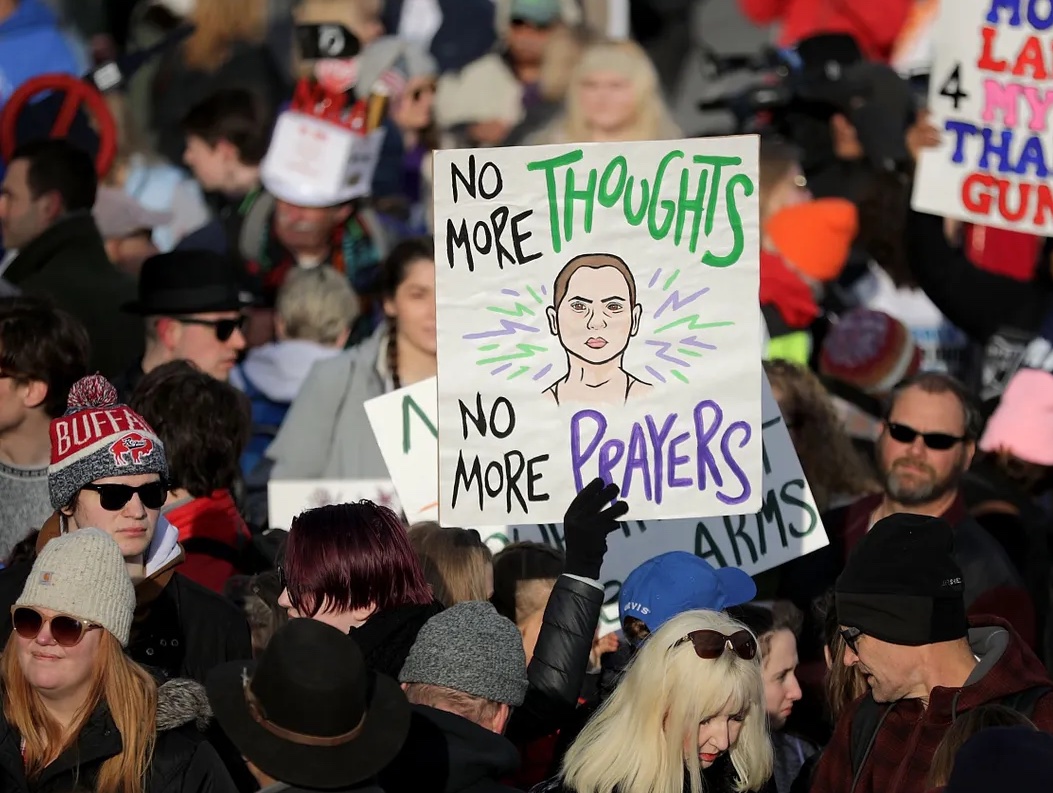
c/o Sophie Jager
I was a freshman in high school when 17 people were killed at Marjory Stoneman Douglas High School in Parkland, Florida. A little more than a week later, my older brother, a high school senior at the time, published a letter to the editor titled “Me Next?” in our small town newspaper. This week I revisited that letter and found myself crying in anger–not for the first time and probably not the last–at the nightmare landscape of gun violence that defines our generation.
My brother and I attended the same school from kindergarten to eighth grade. We grew up in rural Vermont, so there weren’t a lot of options–it was either the brick building off Main Street or nothing at all. Most of my memories from the first half of those nine years are confused and blurry: when I try to conjure up concrete scenes, all I get are half-eaten gingerbread men, grubby subtraction worksheets, and strawberry milk cartons floating around in memory soup. What I do remember, and with astonishing clarity, are the “lockdown” drills that the school conducted each month. On any given day in the middle of English or gym class, the fire alarm would go off, the teacher would lock us in, and we would all silently pack together in whichever corner of the room was hardest to see through the windows or doors. And there was fear, real visceral fear, in the corners of those rooms; those tight crowds of third and fourth grade bodies. Even then, we knew that “lockdown drill” was the school’s delicate way of saying “active shooter drill.”
It hurts to think about the past ten days: a bank in Louisville, Kentucky; a sweet sixteen in Dadeville, Alabama; a highway in Bowdoin, Maine; the wrong doorstep in Kansas City, Missouri.
Then there’s the past three months: an elementary school in Nashville, Tennessee; a house party in Macomb, Illinois; another sweet sixteen in Douglassville, Georgia; a farm in Half Moon Bay, California; a dance studio in Monterey Park, California; a metro station in Washington, D.C.; an academic building at Michigan State University in East Lansing, Michigan.
In the first 15 weeks of 2023, the United States has seen at least 165 mass shootings. That’s more than an average of 1.5 mass shootings every day. This is the worst it’s been in over a decade.
So why aren’t we all talking about it?
When I look around at my Wesleyan world, all I see are the daffodils coming up outside of ’Swings and blankets strewn out in the sun across Foss Hill. I’ve hardly seen news articles about this week’s murders, let alone heard my friends or family mention them. It’s not that nobody has noticed–when I do bring it up, most people are well aware–it’s just become too hard to talk about. There are only so many times we can cry “how horrific,” “I can’t imagine,” “something has to change,” and “enough is enough,” before it starts to sound hollow. There’s nothing new to say.
When I think about the early landmark episodes of gun violence that punctuated my transition into adulthood, I remember details. The times and places of Columbine, Sandy Hook, Pulse Nightclub, and the Las Vegas Strip are stuck in my mind forever. But the specifics of more recent atrocities blur together for me, losing what Founding Editor of Politico John Harris calls “the moral weight they deserve.” The novelty is gone. “Victims,” Harris says, are “losing the dignity of a place in the national narrative.” The more mass shootings there are, the harder it is to prevent the faces and stories from dissolving alongside those strawberry milk cartons into my memory soup.
I returned to my brother’s old letter to the editor this week because I wanted to understand where we went wrong. I remember that period after Parkland in 2018 as one of intense momentum–there were school walkouts, silences, speeches, and protests all across the country. My town even pooled funding to send several buses of students all the way from Vermont to Washington D.C. for the March for Our Lives demonstration on March 24. I made a sign and held it high on Pennsylvania Avenue. When we got back, classes were put on hold for a school-wide screening of X Gonzalez’s speech. My AP Government class spent the following month discussing barriers to gun legislation at the state and national level. In 2018, 72% of voters designated gun policy as an “extremely important” issue. In 2022, that number dropped to just 38%.
Nearly every morning this week I woke up to a news notification on my phone announcing another mass shooting, but nothing in my day-to-day life reflected these murders. The listing I find myself wanting to do as I write this article–of names, places, the number of deaths–is largely powerless. It’s all been done before and yet the shooting continues.
Lawmakers choose guns over kids every time.
I wish I had a better solution to offer here, but I suppose all we can do is keep the conversation going. When our earliest memories consist of active shooter drills and horrific headlines, it’s easy to think about gun violence as something unavoidably baked into the fabric of modern American life. It doesn’t have to be. We have to push back against the narrative that we are powerless, raise up leaders like Tennessee’s Justin Pearson and Justin Jones, and do absolutely everything in our power to avoid complacency.
We can’t stop talking about it.
Sophie Jager can be reached at sjager@wesleyan.edu.
Comments are closed